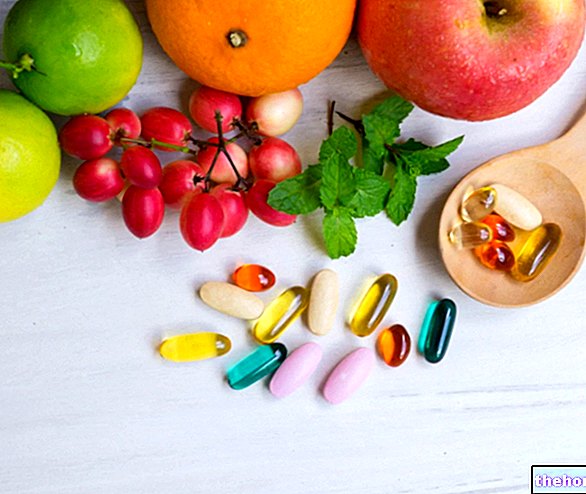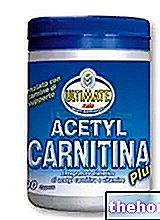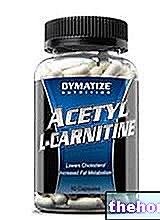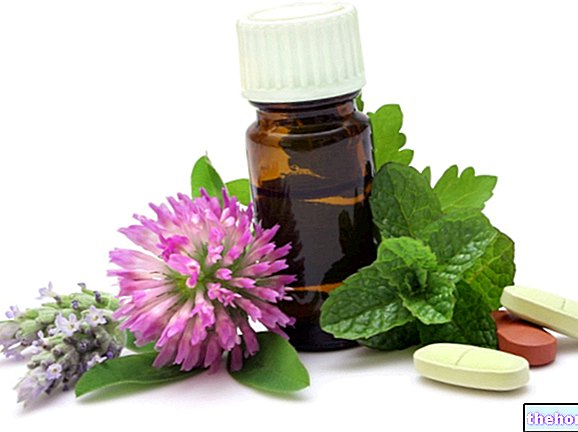
What is Echinacea?
Echinacea, thanks to its immunostimulating properties, is one of the most sought-after medicinal plants in the Italian phytotherapeutic panorama.

Property
Immunostimulating properties
The growing interest in echincacea derives from its ability, largely confirmed by pharmacological studies, to increase resistance to infections. In particular, this plant has proved particularly useful in influenza states and in the prevention of colds.
Deepening: Active Principle and Phytocomplex
Its pharmacological activities can be related to the whole of several constituents, for this reason the single active principles that support them are not known with certainty. This allows us to open a small parenthesis on the concept of active principle and on that of phytocomplex.
The active ingredient is the proven agent that determines the therapeutic actions of a drug or medicinal plant.
The phytocomplex is the "set of molecules extracted directly from the natural source, including the active ingredient. The" set of these substances is responsible for the therapeutic action of the source, which is the same as the active ingredient contained in it, but generally without contraindications associated with its use. All this is made possible by the synergistic action exerted by the various substances, which contribute to modulate the properties of the active principle making it more suitable for herbal rather than pharmacological use.
Returning to echinacea, the juice of the aerial parts and the extracts of the roots have shown important antiviral actions. This characteristic is attributable both to the general immunostimulating effect and to its ability to inhibit the hyaluronidase enzyme which degrades the hyaluronic acid in its fundamental constituents. In addition to being an essential nutrient for articular cartilage, this polysaccharide is part of the composition of the connective tissue, regulating its permeability. Many pathogenic microorganisms, as well as the poisons of snakes, bees and scorpions, contain large amounts of hyaluronidase. This facilitates its penetration into the tissues and, consequently, its pathogenic action. This is why echinacea, by inactivating this enzyme, protects the organism from snake bites and some viruses. As often happens, the benefits that were empirically attributed by indigenous peoples, have been confirmed by science.
If we examine the results of other studies, we realize that other properties of the plant contribute to the antiviral action, conferred on it by different substances: this confirms the importance of the phytocomplex. Thanks to these properties, echinacea is indicated in the treatment of colds, flu, herpes, bronchitis and as an adjunct in the treatment of urinary tract infections.
Deepening - Echinacea Anti-Wrinkle?
The already illustrated abilities of echinacea to:
- on the one hand, inhibit the degradation of hyaluronic acid
- promote wound healing
have prompted some companies to include it in the formulation of anti-wrinkle supplements. In this regard, we remind you that hyaluronic acid plays a very important role at the cutaneous level in preserving the right degree of hydration and firmness of the skin, also exerting a filling action that gives the skin a young and plumped appearance.
Among the anti-wrinkle supplements based on echinacea, we remember the X115® products, in which the extracts of the plant are associated with hyaluronic acid, hydrolyzed collagen, centella asiatica, vitamin C and synergistic antioxidants at high concentrations, for an "intensive action against signs of time (More information).
Other Properties
By stimulating the action of adrenocortical hormones, echinacea exerts a mild cortisone-like effect which explains its discrete anti-inflammatory and anti-arthritic properties.

Echinacea against Cancer
Echinacea is also attributed anti-carcinogenic properties, however, before underlining this type of activity it is necessary to support the claim with further data of clinical relevance. Even if phytotherapy attributes antitumor properties to echinacea, we must not forget that this science collects therapeutic notions belonging to different cultures.
The shamans who populated the plains of South Dakota believed that this plant had the ability to cast out evil demons from the body. For them the evil demon was a "supernatural entity capable of killing the person, for the researcher who has studied their knowledge in order to discover the therapeutic properties of the plant, the demon is the tumor. The researcher who asks the shaman for advice compares then the malignant to cancer, adapting that phytotherapeutic knowledge to one's own intellectual formation.
Thanks to the study of Indian phytotherapy, the researcher attributes antitumor properties to echinacea. However, in order for this claim to be valid, his cultural background obliges him to search for clinical evidence that supports this hypothesis. The scholar will then look for the presence of certain substances endowed with anticarcinogenic properties. Thus, from the study of the echinacea extracts, we have traced back to a substance, called 8-pentadecathene, which seems to possess, in vivo, a "direct antitumor action. This property is reinforced by the action of the echinacoside phytocomplex, which exploits the immunostimulating action of the plant.
Of course, this is preliminary evidence, which is not in the least sufficient to justify the use of echinacea in modern anticancer treatments.
Assumption
On the market, echinacea is available in different formulations: herbal teas (based on dry root powder), juice of aerial parts, tincture and dry extracts. The methods and times of administration vary from product to product; excellent results are obtained with preventive use, which must begin at the onset of the first symptoms associated with flu and other colds.
Video
Analysis of the Properties of Echinacea
Watch the video
- Watch the video on youtube
Contraindications
The use of echinacea is not recommended in case of autoimmune diseases, neoplasms, pregnancy and breastfeeding.
Select plant Fir Acacia Acerola Sorrel Yarrow Yarrow Yarrow Aconito Adatoda Garlic Agnocasto Agrimonia Alchemilla Alkekengi Aloe Altea Witch Hazel Ammi or Visnaga Pineapple Andrographis Anemone Pulsatilla Angelica Anise Star Anise Japanese Star Anise Bitter Orange Bitter Areca Arnica Harpagophytum Arpagophyte Artemisia Asteragus Basil Asparagus Asparagus Peruvian Asparagus Asparagus Asparagus Hawthorn Boldo Borage Shepherd's Purse Boswellia Bucco Butea superba Cocoa Coffee Cajeput Calamus Calamus Marigold Camedrio Chamomile Roman Chamomile Camphor Cinnamon Ceylon Maidenhair Capuchin Artichoke Cardamom Cardiac Thistle Asian Thistle Carvi Cascara Cassia Catecu Catha Cabbage Celandine Chicory Centaurea Cinnamon Cypress Celandine Chives Cypress Coca Cola Colchico Combreto Condurango Comfrey Coriander Cranberry Barberry American Chrysanthemum Cumin Turmeric Damiana Digital Dioscorea Drosera Dulcamara Dunalilella Echinacea Eder a Ephedra Elenio Eleutherococcus Helichrysum Evening primrose Horsetail Alfalfa Erica Euphrasia Erisimo Escolzia Eucalyptus Farfara Farfaraccio Calabar bean Fenugreek Fennel Phytolacca Frangola Ash Fumaria Japanese Mushrooms Galega Ganoderma lucidum Garcinia Cambogia Mulberry Gentian Broom Ginkgo Ginkgo Guipana Guipana Gynestra Ginkgo Hibelia Gymnasium Hibiscus Guarulp St. John's Wort Horse Chestnut Ispaghul Hyssop Jaborandi Kava kava Konjac Laminaria Cherry Laurel Lavender Lemongrass Lespedeza Lovage Icelandic Lichen Lemon Flax Lippia Licorice Lobelia Hops Maca Marjoram Maize Mallow Manna Marrubio Marrubio d "water Matè Melaleuca Meliloto American Lemon balm Myrtle Myrama Walnut Nutmeg Walnut vomica Olive tree Meadowsweet Ononide Opuntia Oregano Orthosiphon Nettle Poppy Papaya Parietaria Feverfew Passiflora Chilli Perilla Periwinkle Phyllanthus Plantain Picrorhiza Pilosella Pino Pisci dia Podofillo Polygala Grapefruit Parsley Psyllium Pueraria mirifica Butcher's broom Pygeum Quassia Oak Rhubarb Ratania Rauwolfia currant Castor bean Rhodiola Rosehip Rosemary Rue Willow Sarsaparilla Sage Elderberry Sassafras Sedum Ergot Senna Serenoa Repens Soybean Solidago Tansy Taraxus Tamarind Tamarind Tamarind Tamarind Tamarindo Ursina Valerian Vanilla Mullein Verbena Veronica Viburnum Vinca Pansy Mistletoe Vine Withania Yohimbe Saffron Ginger Pumpkin Select disease Juvenile Acne Rosacea Tinnitus Tinnitus Aerophagia Tendon Affections Afonia Aphthae Algias Functional Halitosis Breastfeeding Allergy Anemia Anguish Anxiety Arteriosclerosis Asthrosis Asthrosis Arthritis Arthritis Men Sex Woman Blepharitis and Conjunctivitis Eye bags Bronchitis Gallstones Kidney stones Salivary stones Baldness Androgenetic Candida Fragile hair Caries Headache Cellulitis Motion sickness Cystitis C limaterio Cholecystopathy High cholesterol Ulcerative colitis Colonoscopy Contusions Hematoma Convalescence Couperose Depression Dermatitis Diaper dermatitis Diabetes Diarrhea Erectile dysfunction Dyslipidemia Dysmenorrhea Dyspepsia Disturbances of vision Hemorrhoids Epistaxis Herethism Heart disease Fever Fibromyalgia Gastro-intestinal disease Flatulence Hypertension Fibromyalgia Gastrointomnia Jaundice Laryngitis Renal lithiasis Toothache Sore throat Thinness Menopause Meteorism Mononucleosis Alzheimer's disease Crohn's disease Nausea Vomiting Obesity Dark circles Onychomycosis Osteoporosis Dry skin Periarthritis Piorea Low pressure Prostatitis Psoriasis Colds Breast fissures Anal fissures Gastro-nasal rhinitis Senescence Premenstrual Syndrome Sinusitis Quit smoking Overweight Fatty liver Constipation Stomatitis Stress Cough Triglycerides high Ulcer Burns Nails Brittle flashes Heat Warts Dizziness Properties herbal Tanning Abortive adaptogenic Aphrodisiac bittering analgesic anesthetic anorectics analgesic antacid anti-allergic anti-asthmatic Antibiotic catarrh Anticellulitiche anticonvulsant Antidiaforetiche antidiarrheal edematous anthelmintic antiemetic Antiemorroidarie antiphlogistic Antiidrotiche Antinevrotiche Antioxidants antipyretic antirheumatic antiscorbutic Antiseptic antispasmodic anti-uric Aperitive Flavoring Astringent Balsamic Bechiche Capillarotrope Cardiotonic Carminative Cathartic Caustics Healing Cholagogues Choleretic Dyes Decongestants Deodorants Purifying Diaphoretic Cleansers Disinfectants Detoxifiers Thirst quenching Diuretics Exciting Emetics Emmenagogues Emollients Hemostatic Energies Hepatoprotectors Expectorants Eupepticus Moisturisers Galactosensitizers lanti Hypertensive Hypnotic Hypoglycemic Hypotensive Irritants Laxatives Soothing Narcotic Nerves Nutrients Odontalgic Pectoral Purgative Revulsive Remineralizing Refreshing Rubefacient Scialagoghe Sedative Soporifugas Sneezing Stomachic Stomatics Narcotic Vascular Tightenitis




























